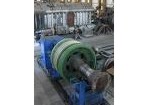
Before being put into operation, electrical machines can be subject to a number of examinations and tests, the purpose of which is to be checked after installation of the machine, its suitability for commissioning, but also to find some defects due to faulty manufacturing, improper storage and installation.
Measurement of insulation resistance
Measurement of insulation against the table and resistance between unrelated parts of the electrical windings of electrical machines is carried out to assess the overall condition of the insulation, the extent of its moisture and dirt.
In this way can't be found separate local defects during operation may cause a break in the insulation.
Insulation resistance is measured during the installation, before placing the machine in prophylactic trials.
Furthermore, insulation of the windings should be checked, clamping bolts of the package, set Temperature switches and others.
The insulation resistance value depends on many factors: the amount of insulation, temperature, degree of humidity, and other surface contamination.
It is not possible to properly assess the condition of the insulation only insulation resistance. However, in many cases, the insulation resistance is measured to determine whether there is a known value adopted for minimum at start up.
The main method for assessing the condition of isolation is a method of comparing the measurements with those made earlier, as well as measurements of different phases. From these data it can very accurately determine whether any changes in insulation resistance due to dirt, moisture, etc.. or is caused by a significant defect in the insulation.
Measurement of insulation with high voltage
Insulation between coil and mass between the phases is tested with high voltage, to determine whether he has the necessary dielectric strength. For this purpose, use alternating sinusoidal voltage of industrial frequency (50 Hz) or DC voltage. Testing of High-voltage isolation is one of the most important and effective methods that establish its suitability for commissioning.
The main merit of the test voltage of industrial frequency correlation of test conditions with working conditions - in both cases the insulation affects the sinusoidal voltage with the same frequency. It can therefore be expected that the breakdown voltage in isolation and the nature of the breach (if the insulation fails) the test will be what they are in operation, and thus test the insulation can be drilled in the weakest position to the impact of work stress.
High-voltage test allows to detect insulation defects in concentrated (cracks, injuries, etc..) But is associated with destruction of the insulation at the defect site.
During transport and storage of the machines in their isolation may appear damaged. Therefore, after installation is necessary to carry out testing and comparing the standards of insulation in a manner described in the relevant standards. This test is required for turbo-generators, hydro generators and synchronous compensators, and the remaining machines are made according to the client.
Measurement of winding resistance
The resistance of the windings of electric motors and other electrical machines in practical cold can be measured after their installation in order to check the symmetry of the phases, the condition of joints and joints to detect compounds.
The resistance of the windings of motors in the cold is necessary for the determination of overheating in their normal mode. The results are compared with data from standard tests of the factory and if the difference between them is significant, you should seek the cause of resistance and amended to remove. In most cases this difference is due to bad solder joints and compounds.
|